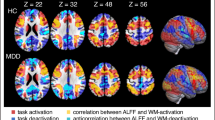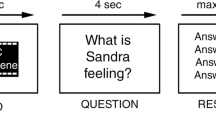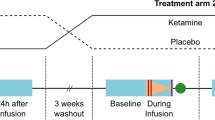Abstract
Preclinical research suggests that N-methyl-D-aspartate glutamate receptors (NMDA-Rs) have a crucial role in working memory (WM). In this study, we investigated the role of NMDA-Rs in the brain activation and connectivity that subserve WM. Because of its importance in WM, the lateral prefrontal cortex, particularly the dorsolateral prefrontal cortex and its connections, were the focus of analyses. Healthy participants (n=22) participated in a single functional magnetic resonance imaging session. They received saline and then the NMDA-R antagonist ketamine while performing a spatial WM task. Time-course analysis was used to compare lateral prefrontal activation during saline and ketamine administration. Seed-based functional connectivity analysis was used to compare dorsolateral prefrontal connectivity during the two conditions and global-based connectivity was used to test for laterality in these effects. Ketamine reduced accuracy on the spatial WM task and brain activation during the encoding and early maintenance (EEM) period of task trials. Decrements in task-related activation during EEM were related to performance deficits. Ketamine reduced connectivity in the DPFC network bilaterally, and region-specific reductions in connectivity were related to performance. These results support the hypothesis that NMDA-Rs are critical for WM. The knowledge gained may be helpful in understanding disorders that might involve glutamatergic deficits such as schizophrenia and developing better treatments.
Similar content being viewed by others
Log in or create a free account to read this content
Gain free access to this article, as well as selected content from this journal and more on nature.com
or
References
Abel K, Allin MPG, Kucharska Pietura K, David A, Andrew C, Williams S et al (2003). Ketamine alters neural processing of facial emotion recognition in healthy men: an fMRI study. Neuroreport 14: 387–391.
Anis NA, Berry SC, Burton NR, Lodge D (1983). The dissociative anaesthetics, ketamine and phencyclidine, selectively reduce excitation of central mammalian neurones by N-methyl-aspartate. Br J Pharmacol 79: 565–575.
Arnsten AFT (2011). Prefrontal cortical network connections: key site of vulnerability in stress and schizophrenia. Int J Dev Neurosci 29: 215–223.
Baddeley AD (1992). Working memory. Science 255: 556–559.
Baron SP, Wenger GR (2001). Effects of drugs of abuse on response accuracy and bias under a delayed matching-to-sample procedure in squirrel monkeys. Behav Pharmacol 12: 247–256.
Bell M, Lysaker P, Beam-Goulet J, Milstein R, Lindemayer J (1994). Five-component model of schizophrenia: assessing the factorial invariance of the positive and negative syndrome scale. Psychiatry Res 52: 295–303.
Biswal B, Yetkin FZ, Haughton VM, Hyde JS (1995). Functional connectivity in the motor cortex of resting human brain using echo-planar MRI. Magnetic Resonance in Medicine 34: 537–541.
Brown H, Prescott R (1999) Applied Mixed Models in Medicine. John Wiley & Sons, LTD: Chichester.
Castner S, Williams GV (2007). Tuning the engine of cognition: a focus on NMDA/D1 receptor interactions in prefrontal cortex. Brain Cogn 63: 94–122.
Cohen ML, Chan SL, Bhargava HN, Trevor AJ (1974). Inhibition of mammalian brain acetylcholinesterase by ketamine. Biochem Pharmacol 23: 1647–1652.
Cole M, Yarkoni T, Repovs G, Anticevic A, Braver T (2012). Global connectivity of prefrontal cortex predicts cognitive control and intelligence. J Neurosci 32: 8988–8999.
Cole MW, Anticevic A, Repovs G, Barch D (2011). Variable Global Dysconnectivity and Individual Differences in Schizophrenia. Biol Psychiatry 70: 43–50.
Cole MW, Pathak S, Schneider W (2010). Identifying the brain's most globally connected regions. NeuroImage 49: 3132–3148.
Courtney SM, Petit L, Maisog JM, Ungerleider LG, Haxby JV (1998). An area specialized for spatial working memory in human frontal cortex. Science 279: 1347–1351.
Courtney SM, Ungerleider LG, Keil K, Haxby JV (1997). Transient and sustained activity in a distributed neural system for human working memory. Nature 386: 608–611.
Dolcos F, Kragel P, Wang L, McCarthy G (2006a). Role of the inferior frontal cortex in coping with distracting emotions. Neuroreport 17: 1591–1594.
Dolcos F, McCarthy G (2006b). Brain systems mediating cognitive interference by emotional distraction. J Neurosci 26: 2072–2079.
Dosenbach NUF, Fair DA, Miezin FM, Cohen AL, Wenger KK, Dosenbach RAT et al (2007). Distinct brain networks for adaptive and stable task control in humans. Proc Natl Acad Sci USA 104: 11073–11078.
Dosenbach NUF, Visscher KM, Palmer ED, Miezin FM, Wenger KK, Kang HC et al (2006). A core system for the implementation of task sets. Neuron 50: 799–812.
Driesen N, Leung H, Calhoun V, Constable R, Gueorguieva R, Hoffman R et al (2008). Impairment of working memory maintenance and response in schizophrenia: functional magnetic resonance imaging evidence. Biol Psychiatry 64: 1026–1034.
Driesen N, McCarthy G, Bloch M, He G, Morgan P, Krystal JH (unpublished). Guanfacine moderates activation and connectivity under NMDA blockade.
Driesen NR, McCarthy G, Bhagwagar Z, Bloch M, Calhoun V, D’Souza DC et al (2013). Relationship of resting brain hyperconnectivity and schizophrenia-like symptoms produced by the NMDA receptor antagonist ketamine in humans. Mol Psychiatry (e-pub ahead of print, 22 January 2013; doi:10.1038/mp.2012.194).
D’Esposito M, Aguirre GK, Zarahn E, Ballard D, Shin RK, Lease J (1998). Functional MRI studies of spatial and nonspatial working memory. Brain Res 7: 1–13.
Fellous J-M, Sejnowski TJ (2003). Regulation of persistent activity by background inhibition in an in vitro model of a cortical microcircuit. Cereb Cortex 13: 1232–1241.
Fitzgerald M, Gruener G, Mtui E (2011) Clinical Neuroanatomy and Neuroscience. Saunders.
Frederick DL, Gillam MP, Allen RR, Paule MG (1995). Acute behavioral effects of phencyclidine on rhesus monkey performance in an operant test battery. Pharmacol Biochem Behav 52: 789–797.
Fu CHY, Abel K, Allin MPG, Gasston D, Costafreda S, Suckling J et al (2005). Effects of ketamine on prefrontal and striatal regions in an overt verbal fluency task: a functional magnetic resonance imaging study. Psychopharmacology 183: 92–102.
Fuster JM, Alexander GE (1971). Neuron activity related to short-term memory. Science 173: 652–654.
Ghoneim MM, Hinrichs JV, Mewaldt SP, Petersen RC (1985). Ketamine: behavioral effects of subanesthetic doses. J Clin Psychopharmacol 5: 70–77.
Goldman-Rakic P (1995). Cellular basis of working memory. Neuron 14: 477–485.
Grunze HC, Rainnie DG, Hasselmo ME, Barkai E, Hearn EF, McCarley RW et al (1996). NMDA-dependent modulation of CA1 local circuit inhibition. J Neurosci 16: 2034–2043.
Gueorguieva R, Krystal JH (2004). Move over ANOVA: progress in analyzing repeated-measures data and its reflection in papers published in the archives of general psychiatry. Arch Gen Psychiatry 61: 310–317.
Hampson M, Peterson BS, Skudlarski P, Gatenby JC, Gore JC (2002). Detection of functional connectivity using temporal correlations in MR images. Hum Brain Mapp 15: 247–262.
Homayoun H, Moghaddam B (2007). NMDA receptor hypofunction produces opposite effects on prefrontal cortex interneurons and pyramidal neurons. J Neurosci 27: 11496–11500.
Homayoun H, Stefani MR, Adams BW, Tamagan GD, Moghaddam B (2004). Functional interaction between NMDA and mGlu5 receptors: effects on working memory, instrumental learning, motor behaviors, and dopamine release. Neuropsychopharmacology 29: 1259–1269.
Honey RAE, Honey GD, O’Loughlin C, Sharar SR, Kumaran D, Bullmore ET et al (2004). Acute ketamine administration alters the brain responses to executive demands in a verbal working memory task: an fMRI study. Neuropsychopharmacology 29: 1203–1214.
Jackson ME, Homayoun H, Moghaddam B (2004). NMDA receptor hypofunction produces concommitant firing rate potentiation and burst activity reduction in the prefrontal cortex. Neuroscience 101: 8467–8472.
Kay S, Opler L, Fiszbein A (1986) Positive and Negative Syndrome Scale. Multi-Health Systems, Inc.: Toronto, Ontario.
Krystal J, Abi Saab W, Perry E, D’Souza DC, Liu N, Gueorguieva R et al (2005a). Preliminary evidence of attenuation of the disruptive effects of the NMDA glutamate receptor antagonist, ketamine, on working memory by pretreatment with the group II metabotropic glutamate receptor agonist, LY354740, in healthy human subjects. Psychopharmacology 179: 303–309.
Krystal JH, Abi-Saab W, Perry E, D’Souza DC, Liu N, Gueorguieva R et al (2005b). Preliminary evidence of attenuation of the disruptive effects of the NMDA glutamate receptor antagonist, ketamine, on working memory by pretreatment with the group II metabotropic glutamate receptor agonist, LY354740, in healthy human subjects. Psychopharmacology 179: 303–309.
Krystal JH, Bennett A, Abi Saab D, Belger A, Karper LP, D'Souza DC et al (2000). Dissociation of ketamine effects on rule acquisition and rule implementation: possible relevance to NMDA receptor contributions to executive cognitive functions. Biol Psychiatry 47: 137–143.
Krystal JH, D’Souza DC, Karper LP, Bennett A, Abi-Dargham A, Abi-Saab D et al (1999). Interactive effects of subanesthetic ketamine and haloperidol in healthy humans. Psychopharmacology 145: 193–204.
Krystal JH, Karper LP, Bennett A, D’Souza DC, Abi Dargham A, Morrissey K et al (1998). Interactive effects of subanesthetic ketamine and subhypnotic lorazepam in humans. Psychopharmacology 135: 213–229.
Krystal JH, Karper LP, Seibyl JP, Freeman GK, Delaney R, Bremner JD et al (1994). Subanesthetic effects of the noncompetitive NMDA antagonist, ketamine, in humans: psychotomimetic, perceptual, cognitive, and neuroendocrine responses. Arch Gen Psychiatry 51: 199–214.
Leung HC, Gore JC, Goldman-Rakic PS (2002). Sustained mnemonic response in the human middle frontal gyrus during on-line storage of spatial memoranda. J Cogn Neurosci 14: 659–671.
Leung HC, Seelig D, Gore JC (2004). The effect of memory load on cortical activity in the working memory circuit. Cogn Affect Behav Neurosci 4: 553–563.
Lisman JE, Fellous J-M, Wang X-J (1998). A role for NMDA-receptor channels in working memory. Nat Neurosci 1: 273–276.
Maccaferri G, Dingledine R (2002). Control of feedforward dendritic inhibition by NMDA receptor-dependent spike timing in hippocampal interneurons. J Neurosci 22: 5462–5472.
Moghaddam B, Adams B, Verma A, Daly D (1997). Activation of glutamatergic neurotransmission by ketamine: a novel step in the pathway from NMDA receptor blockade to dopaminergic and cognitive disruptions associated with the prefrontal cortex. J Neurosci 17: 2921–2927.
Moghaddam B, Adams BW (1998). Reversal of phencyclidine effects by a group II metabotropic glutamate receptor agonist in rats. Science 281: 1349–1352.
Newcomer JW, Krystal JH (2001). NMDA receptor regulation of memory and behavior in humans. Hippocampus 11: 529–542.
Oye I, Paulsen O, Maurset A (1992). Effects of ketamine on sensory perception: evidence for a role of N-methyl-D-aspartate receptors. J Pharmacol Exp Ther 260: 1209–1213.
Oye N, Hustvelt O, Moberg ER, Pausen O, Skoglund LS (1991). The chiral forms of ketamine as probed for NMDA receptor function in humans. In: Kameyama T, Nabeshima T, Domino E (eds). NMDA Receptor Related Agents: Biochemistry, Pharmacology, and Behavior Vol 381–389.. NPP Books: Ann Arbor, MI.
Raichle M, MacLeod A, Snyder A, Powers W, Gusnard D, Shulman G (2001). A Default mode of brain function. Proc Natl Acad Sci USA 98: 676–682.
Rao S, Williams G, Goldman-Rakic P (2000). Destruction and creation of spatial tuning by disinhibition: GABAA blockade of prefrontal cortical neurons engaged by working memory. J Neurosci 20: 485–494.
Roberts BM, Shaffer CL, Seymour PA, Schmidt CJ, Williams GV, Castner SA (2010). Glycine transporter inhibition reverses ketamine-induced working memory deficits. Neuroreport 21: 390–394.
Seamans J, Yang C (2004). The principal features and mechanisms of dopamine modulation in the prefrontal cortex. Prog Neurobiol 74: 1–57.
Seamans JK, Nogueira L, Lavin A (2003). Synaptic basis of persistent activity in prefrontal cortex in vivo and in organotypic cultures. Cereb Cortex 13: 1242–1250.
Smith DJ, Westfall DP, Adams JD (1980). Ketamine interacts with opiate receptors as an agonist. Anesthesiology 53: S5.
Smith EE, Jonides J, Koeppe RA (1996). Dissociating verbal and spatial working memory using PET. Cereb Cortex 6: 11–20.
Smith EE, Jonides J, Marshuetz C, Koeppe RA (1998). Components of verbal working memory: evidence from neuroimaging. Proc Natl Acad Sci USA 95: 876–882.
Vollenweider F, Leenders K, Scharfetter C, Antonini A, Maguire P, Missimer J et al (1997). Metabolic hyperfrontality and psychopathology in the ketamine model of psychosis using positron emission tomography (PET) and [18F]fluorodeoxyglucose (FDG). Eur Neuropsychopharmacol 7: 9–24.
Wang M, Gamo N, Yang Y, Jin L, Wang X-J, Laubach M et al (2011). Neuronal basis of age-related working memory decline. Nature 476: 210–213.
Wang M, Vijayraghavan S, Goldman-Rakic PS (2004). Selective D2 receptor actions on the functional circuitry of working memory. Science 303: 853–856.
Wang M, Yang Y, Wang C-J, Gamo Nao J, Jin Lu E, Mazer James A et al (2013). NMDA Receptors Subserve Persistent Neuronal Firing during Working Memory in Dorsolateral Prefrontal Cortex. Neuron 77: 736–749.
Wood J, Kim Y, Moghaddam B (2012). Disruption of prefrontal cortex large scale neuronal activity by different classes of psychotomimetic drugs. J Neurosci 32: 3022–3031.
Acknowledgements
Dr Driesen thanks the following individuals: Dr Amy Arnsten provided helpful comments regarding this manuscript and related topics. Drs Michelle Hampson and Pawel Skudlarski provided advice regarding the connectivity analysis. Cheryl Lacadie helped informally with a number of image processing and software issues. Kathleen Maloney, Julie Holub, Cara Cordeaux, and Nikia McFadden served as research assistants. Nursing care was provided by the Yale Center for Clinical Investigation and the Biostudies Unit, Neurobiological Diagnostic Studies Unit of the VA CT Healthcare System, West Haven, CT, USA. MRI technologists Hedy Sarofin and Karen A Martin supplied expert assistance for this complex MRI protocol. This study was supported by Yale-Pfizer Alliance (NRD); National Alliance for Research on Schizophrenia and Depression-Distinguished Investigator Award (JHK) and Young Investigator Award (ZB); Conte Center Calcium Signaling and Prefrontal Deficits in Schizophrenia, NIMH; National Center for Post-Traumatic Stress Disorder, Clinical Neurosciences Division, West Haven, CT, USA; National Institute on Alcohol Abuse and Alcoholism, 2P50 AA 012870; US Department of Veterans Affairs Alcohol Research Center; NIH National Center for Research Resources CTSA Grant Number UL1 RR024139; NIH Grant Number K23-MH077914; and the State of CT Department of Mental Health and Addiction Services.
Author information
Authors and Affiliations
Corresponding author
Additional information
Data from this paper were presented at the May 2012 Biological Psychiatry and June 2013 Human Brain Mapping meetings.
Supplementary Information accompanies the paper on the Neuropsychopharmacology website
Supplementary information
Rights and permissions
About this article
Cite this article
Driesen, N., McCarthy, G., Bhagwagar, Z. et al. The Impact of NMDA Receptor Blockade on Human Working Memory-Related Prefrontal Function and Connectivity. Neuropsychopharmacol 38, 2613–2622 (2013). https://doi.org/10.1038/npp.2013.170
Received:
Revised:
Accepted:
Published:
Issue date:
DOI: https://doi.org/10.1038/npp.2013.170
Keywords
This article is cited by
-
Assessing the mechanisms of brain plasticity by transcranial magnetic stimulation
Neuropsychopharmacology (2023)
-
Aberrant maturation and connectivity of prefrontal cortex in schizophrenia—contribution of NMDA receptor development and hypofunction
Molecular Psychiatry (2022)
-
Effects of neuroactive metabolites of the tryptophan pathway on working memory and cortical thickness in schizophrenia
Translational Psychiatry (2021)
-
(R,S)-ketamine and (2R,6R)-hydroxynorketamine differentially affect memory as a function of dosing frequency
Translational Psychiatry (2021)
-
Effects of Ketamine and Midazolam on Simultaneous EEG/fMRI Data During Working Memory Processes
Brain Topography (2021)



